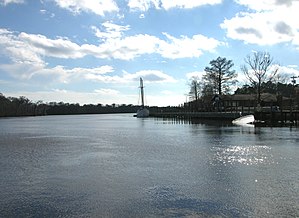Waccamaw River

The Waccamaw River is a
Description
It enters
Navigable as far as Conway, the lower river has been an important commercial route for European settlers in the region since the 18th century. Before that, it was equally important for various Native American cultures.
In the 19th century, planters developed extensive
Since the early 20th century, the Waccamaw's lower course in South Carolina forms part of what is now known as the
In addition, the river's extensive
"Extensive forest communities cover the Waccamaw floodplain, including cypress-gum swamp and bottomland hardwood forests. The bottomland hardwood forests of the Waccamaw are unique in the Carolinas in containing abundant Atlantic white cedar and live oaks, along with the more typical laurel and overcup oak and loblolly pine."[1]
The Nature Conservancy has acquired a portion of the habitat for conservation and preservation. They control land along the Waccamaw, the lower Pee Dee and Little Pee Dee rivers for habitat preservation.
A much larger area was acquired by the federal government for the Waccamaw National Wildlife Refuge, established in 1997 near the confluence of these three rivers. Originally consisting of 22,931 acres (92.80 km2), it is planned to have a total of 50,000 acres (200 km2).[2]
See also
- List of North Carolina rivers
- List of South Carolina rivers
References
- ^ *The Nature Conservancy: Waccamaw River Preserve, accessed 18 Feb 2010
- ^ Official refuge site
External links
- Winyah Rivers Foundation: About the Waccamaw River
- Albergotti, Dan. "Shadows Along the Waccamaw" Southern Spaces, November 24, 2008.
